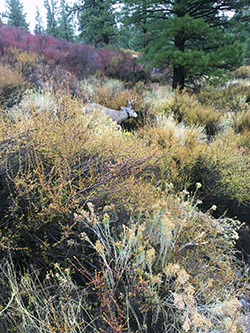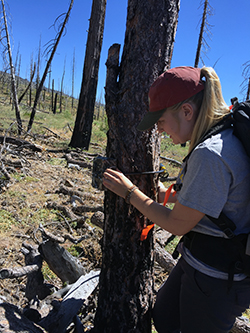

Deer population estimates are an important element of the California Department of Fish and Wildlife’s (CDFW) management decisions regarding the species – including setting quotas for deer-hunting seasons, acquiring land and identifying habitat improvement projects. Historically, CDFW has relied upon helicopter surveys to obtain these population estimates, but such surveys can be problematic. While they are effective in open and largely flat areas, they are less so in tree-laden areas where deer are hidden from sight. They can also be extremely expensive.
Now, thanks to emerging DNA technology, scientists are exploring a less invasive, cost-effective alternative: Analysis of what the deer leave behind.
The use of DNA is not new, of course – CDFW has used hair or tissue samples to extract DNA and identify individual animals for years. But scientists are finding that the painstaking collection and analysis of deer droppings is particularly useful because it allows them to gather the necessary information without physically touching (or stressing) the animals. And that, one might say, is the “bottom line.”
Fecal DNA analysis is being used by wildlife biologists in the North Central Region as part of a six-year region-wide study of mule deer (Odocoileus hemionus) that will provide population estimates in areas where data has previously been lacking. CDFW scientists, in cooperation with UC Davis, will use the deer pellets to take a genetic “fingerprint” designed to help estimate deer populations.
Starting in 2016, a crew began setting transects for pellet collection in the standardized sampling locations (known to hunters as deer zones X6a/b, X7a/b and X8) which are located in Lassen, Plumas, Sierra, Nevada, Placer and Alpine counties. After starting points were randomly selected, habitat information and pictures were collected along with fresh pellets. After the pellets were removed from the area in an initial sweep, scientists revisited the transect once a week for three more weeks to collect new samples. Between July and September of 2016, biologists visited 43 different transects in the summer range and collected and analyzed 458 fresh pellet samples. Staff also captured 20 does and seven bucks and fit them with satellite collars that produced data that helped identify summer home ranges.
CDFW will also use DNA to identify individual deer to help gather buck/doe/fawn ratios. Biologists will then combine the DNA data with home range data from collared deer to calculate the estimated number of deer in the population. This year staff have already completed another 36 plots and collared 18 more deer. Another series of pellet collections is scheduled next year, with a goal of continuing until all 17 counties in the region have been sampled.
Although several DNA projects are occurring across the state, this project is the largest landscape-level study for deer in California. The study is funded through CDFW’s Big Game Account, a dedicated account that provides research and management funds for game species. The University of California will conduct the laboratory work and statistical analysis.